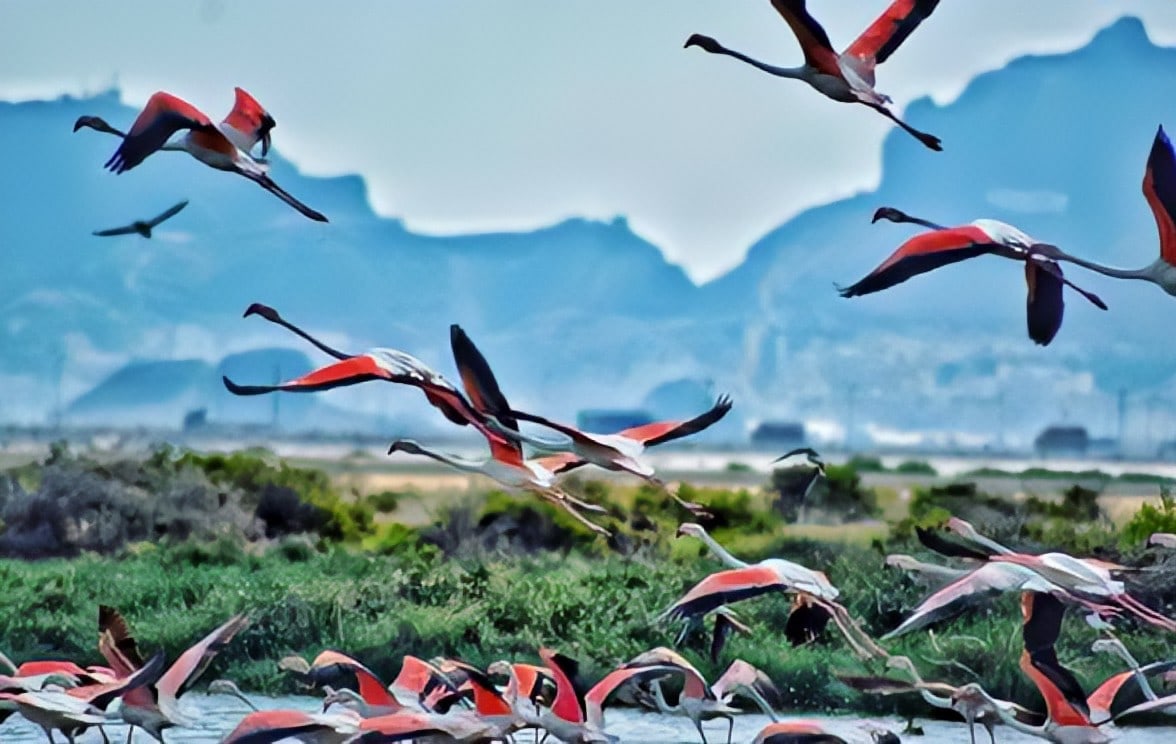
Waterfowl inside Aden’s wetlands (Mohammed Khalid)
Last updated on: 09-11-2023 at 1 PM Aden Time

“The Pelican Lake Reserve served as an outlet for residents and tourists. However, with the declaration of the Yemeni Unity in 1990, this area has been gradually neglected.”
Abdullatif Salmeen (South24)
The Pelican Lake Reserve (PLR) in Aden, once touted as among the most important natural sanctuaries for migratory birds in Yemen and the entire region, is today a sad story of neglect and apathy, with its most important winged visitors now rarely to be seen.
The Pelican Lake Reserve is part of the wetland reserves in Aden that were officially announced in August 2006. They are also documented as one of 16 wetlands at the regional level.
The wetland’s reserves extend from Khur Maksar District to Al-Mansoura District in Aden Governorate in South Yemen. The water level at the reserves ranges between a few centimeters to six meters from the lowest sea level (the tidal status), and covers a total area of 110 hectares. PLR is considered among the most important five reserves in Yemen, including Al-Haswa, Al-Mamlah, Masab Al-Wadi Al-Kabeer and Bir Ahmed.
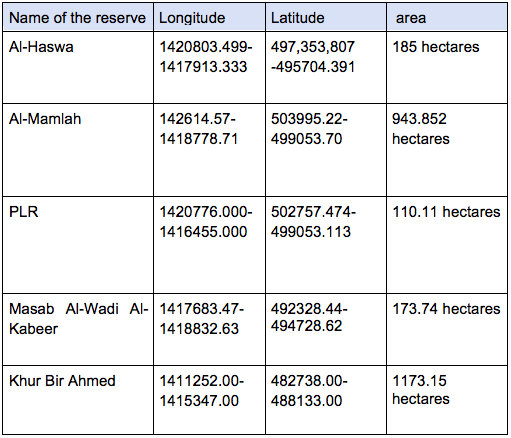
Source: Holm Akhdar.
During the winter, from October to February each year, some 10,000 birds, including 150 different water and wading bird species would wing their way to PLR as part of the winter migration from Europe to Africa. The attractive factor for these birds was the abundance of small fish in the wetlands. In addition, PLR is sheltered from severe climate changes. The most famous species to visit the reserve include pelicans, flamingos, the white-eyed gull, eastern imperial eagle, heron and other birds.
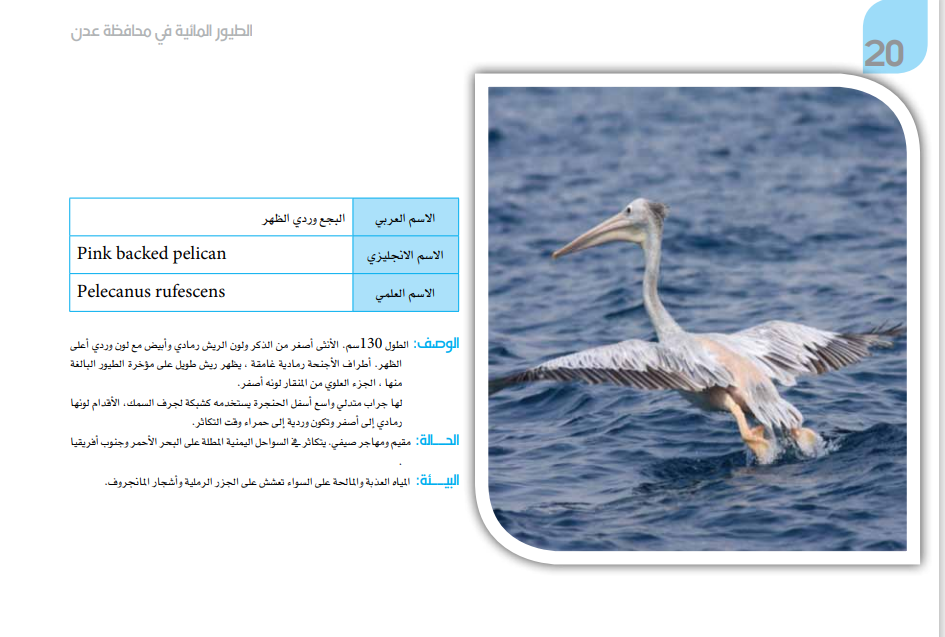
Part of waterfowl in Aden (Waterfowl in Aden: Instruction Manual-Yemeni Ministry of Water and Environment-The United Nations Development Programme (UNDP).
English name: Pink-backed pelican.
The scientific name: Pelecanus rufescens.
Description: It is 130 cm long. The female is more yellow than the male. The plumage is gray and white. It has a pinkish hue on the back. The top of the wings is dark gray. Adults have long feather plumes. The upper part of the beak is yellow. It has a large dangling pouch at the bottom of the larynx used as a net to shovel fish. The legs range between gray and yellow. During reproduction, the legs range between pink and red.
The status: A resident summer migratory bird. It produces offspring in the northern coasts overlooking the Red Sea and South Africa.
The environment: Both fresh and saltwater. It nests on the sandy isles and the mangrove trees.
For the past many years, PLR has been badly neglected in a way that has led to decrease in the number of migratory birds. Its once pristine environment has been polluted with the accumulation of human wastes, rise in the population of hostile crows, construction of random buildings and backfilling of large areas of the reserve. In a pointer to its unkempt state, the Pelican Reserve has lost most of its human visitors who would come for sightseeing from Aden and outside and enjoy the scenery.
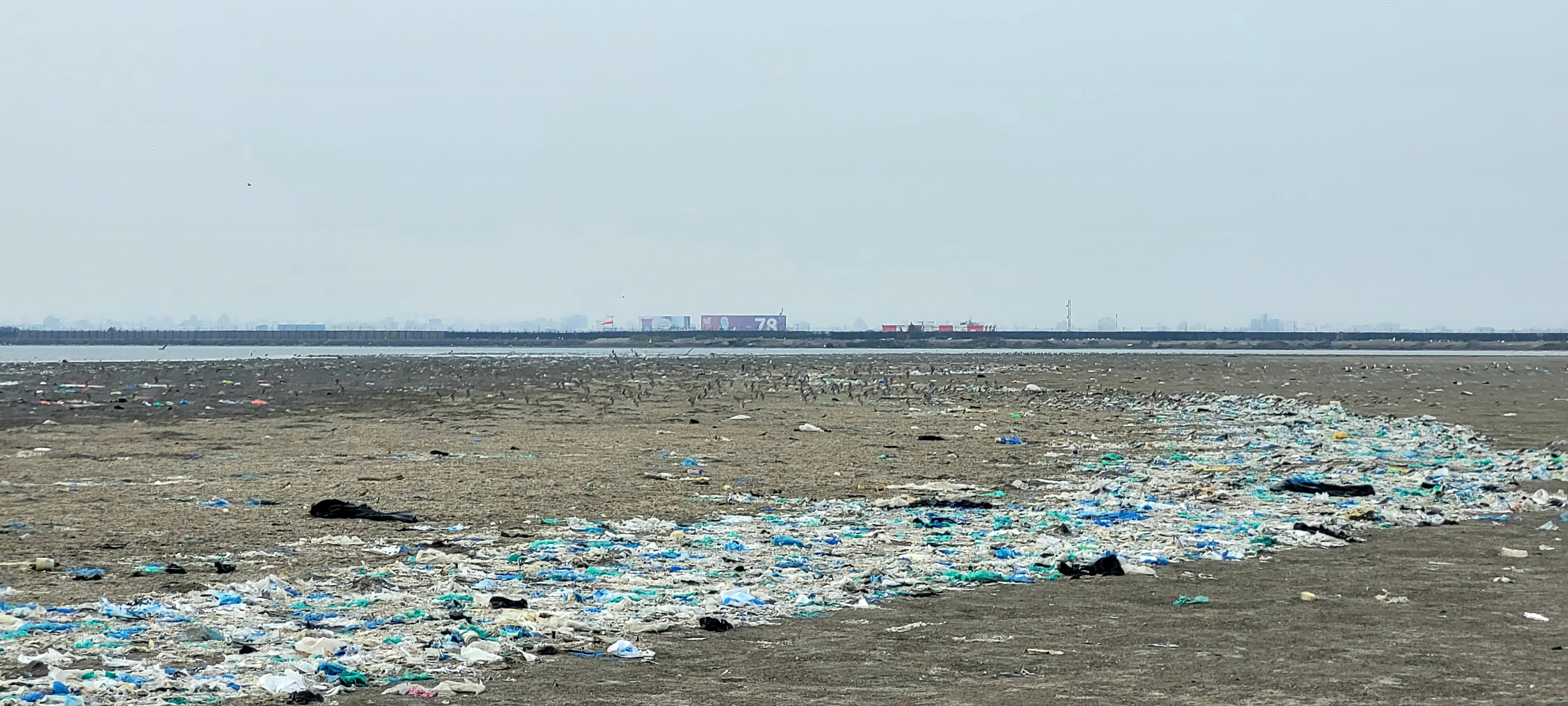
Garbage piles up: Environmental pollution in PLR in Aden, October 27, 2023 (South24 Center).
Crucial Environmental Significance
Wetlands occur wherever land and water meet, and are characterized by flooding or saturation of the soil, such as along coasts, lakes and salt marshes. Seawater rises and recedes regularly over these lands. This environment is incredibly beautiful along with its vital nature and the wide biological resources it nourishes as well as the distinctive economic activities it supports. Furthermore, it has environmental importance for improving the climate.
Dr. Jamal Mohamed Bawazir, Professor of Environmental Sciences in the University of Aden, told 'South24 Center': "PLR is an important site for the reproduction of marine organisms, especially fish. PLR is under the protection and management of the Public Authority for Environmental Protection (PAEP) although it is owned by the Free Zone in Aden.”

Part of waterfowl in Aden (Waterfowl in Aden: Instruction Manual-Yemeni Ministry of Water and Environment-The United Nations Development Programme (UNDP).
English name: Crab Plover.
Scientific name: Dromas Ardeola.
Description: The bird is 39 cm long. A medium-sized coastal bird with a big head and a huge black beak. It has long blue legs. The plumage is black and white. The black colour is limited to the back, shoulders, and the edges of the wings while the other parts of the body are white.
The status: It is a resident wanderer bird. The bird produces offspring on the Yemeni isles of the Red Sea.
Environment: Coasts, water bodies and coral reefs.
It produces offspring in the form of colonies and builds its nests inside tunnels it digs in sandy areas.
He added: "There is no certain date attributed to the emergence of Aden’s lakes as they were part of the maritime areas in Bandar Al-Tawahi*. However, during building the maritime road, corridors were established to allow the flow of seawater to the lakes during tides. Seawater flows under the bridge into the salt ponds to meet salt production needs.“ (*A bay located in Aden)
Dangerous pollution
During the field visit to PLR in Aden, the ‘South24 Center’ correspondent was captivated by the beautiful and calm atmosphere of the reserve, but its derelict condition was all too evident. In the past, the reserve would hum with the activity of flocks of nesting migratory and rare birds. However, this has changed as the place has become almost deserted, except for very few birds.
In an eyesore, construction waste and garbage have been allowed to pile up at the edge of the reserve. This constitutes an environmental hazard and endangers the existence of migratory birds and maritime life.
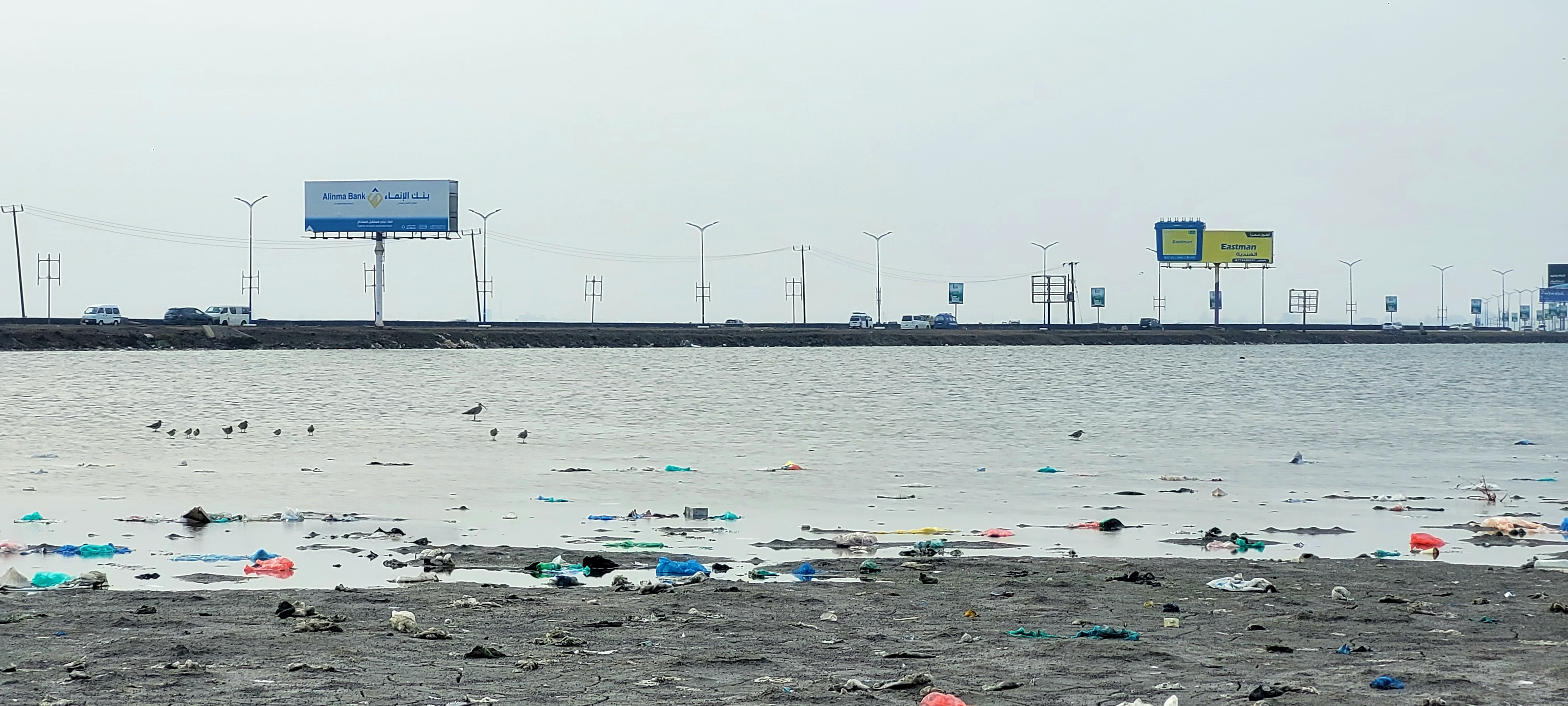
Garbage littering the lake: Environmental pollution in PLR in Aden, October 27, 2023 (South24 Center).
Dr. Bawazir indicated that PLR has remained away from the attention of the state and relevant institutions over the past years. He explained: "Attention previously focused on Al-Haswah Reserve in Aden. The other four reserves have not received the same degree of attention."
He noted that Masab Al-Wadi Al-Kabeer is also suffering from the onslaught of the destructive urban sprawl. The reserve has become the home of concrete buildings after uprooting of hundreds of trees.
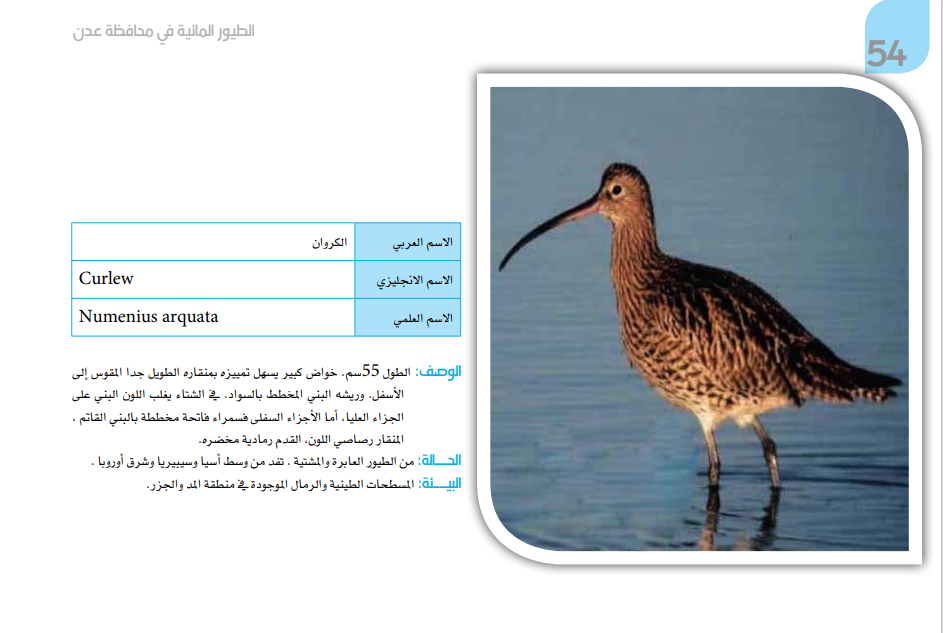
Part of waterfowl in Aden (Waterfowl in Aden: Instruction Manual-Yemeni Ministry of Water and Environment-The United Nations Development Programme (UNDP).
English name: Curlew.
Scientific name: Numenius arquata.
Description: The bird is 55 cm long. It is a big wader which is easily distinguished by its exceptionally long downward- curved beak. Its brown plumage is mottled with black. In winter, the upper part is predominantly brown. The lower parts are light black streaked with mahogany brown. The beak is grey while the feet are greenish grey.
Status: It is a transcontinental winter bird that migrates from Central Asia, Siberia, and Eastern Europe.
Environment: Muddy and sandy bodies in the intertidal areas.
Bawazir pointed out that solid waste and plastic materials dumped in the PLR have severely endangered the lake and its biological components. The reduction of the reserve’s land has led to the accumulation of the waste. Additionally, “the plastic bags distort the aesthetic view of the lake and affect the waterfowls. These bags do not decompose quickly and kill plant and animal marine organisms.”
Hajj Mohammed, who lives in the old city of Crater, said he feels sad seeing the current condition of PLR. He told ‘South24 Center’ that the reserve served as an outlet for residents and tourists. However, “with the declaration of the Yemeni Unity in 1990*, this area has been gradually neglected”. (*When Yemen's north and south merged as one nation on 22 May 1990)
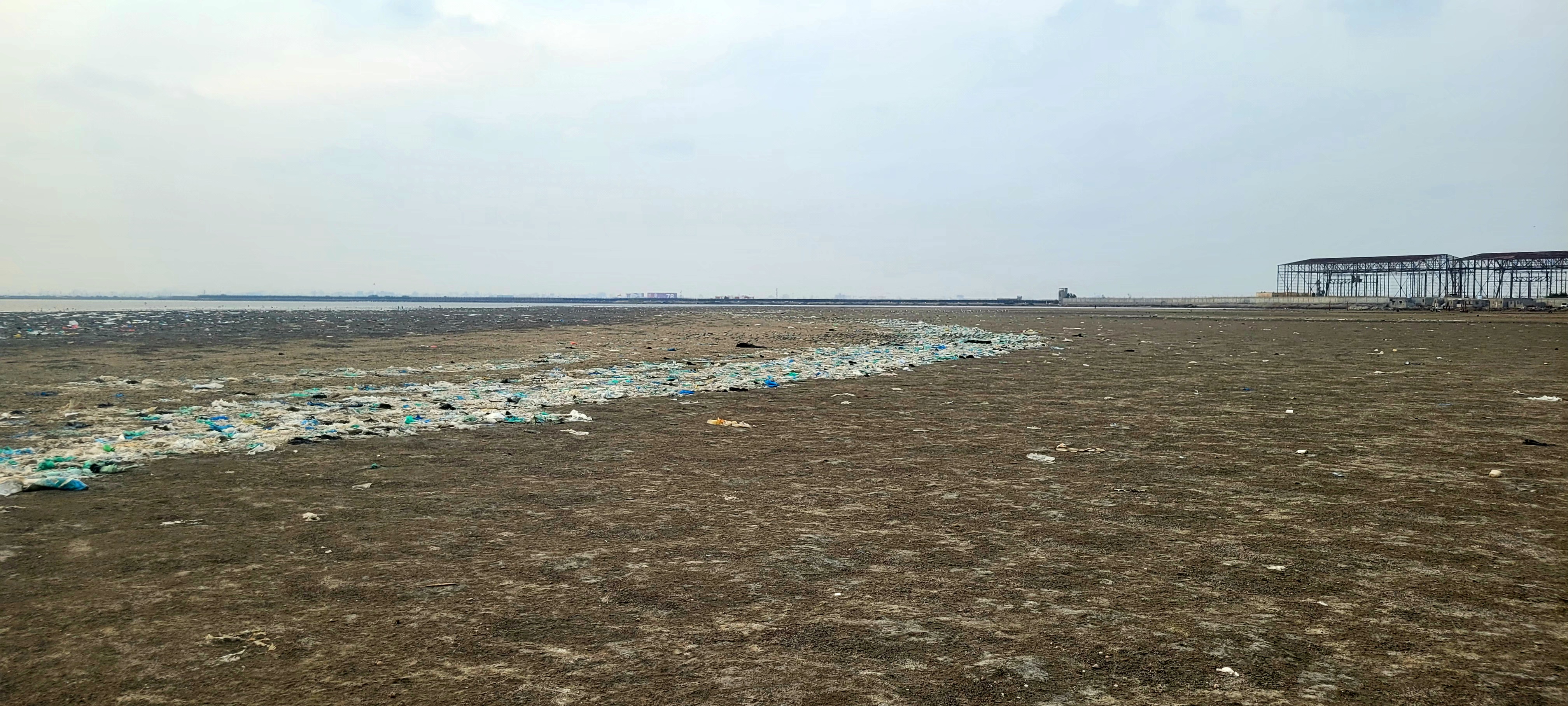
Plastic waste piles up in PLR in Aden, October 27, 2023 (South24 Center).
However, Eng. Niazi Moustafa, General Manager of the PAEP, denied that the authority has neglected the Pelican Reserve. He told ‘South24 Center’: “It is not true that we ignore or neglect the reserve. We always stress on the need to protect all reserves in Aden.”
He explained that “some measures were taken by PAEP including installing awareness banners and organizing scientific tours for students to visit PLR and watch the waterfowl.”
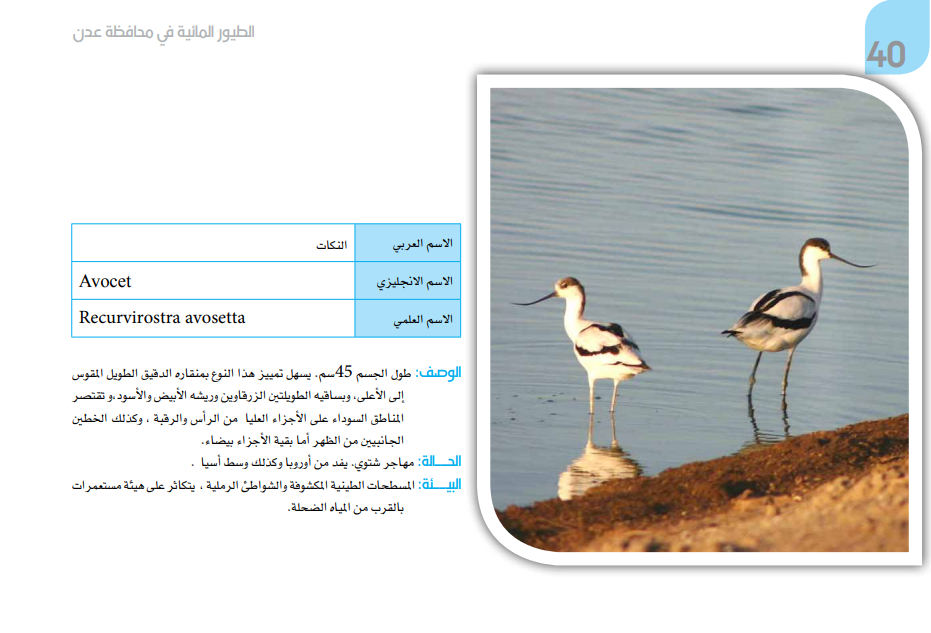
Part of waterfowl in Aden (Waterfowl in Aden: Instruction Manual-Yemeni Ministry of Water and Environment-The United Nations Development Programme (UNDP).
English name: Avocet.
Scientific name: Recurvirostra.
Description: The bird is 45 cm long. It can be easily distinguished by its thin long upward curved beak. It has two long blue legs and white and black plumage. The upper parts of head and neck are black as well as the two side lines on its back. The other parts are white.
Status: A winter migratory bird that comes from Europe and Central Asia.
Environment: Open muddy bodies and sandy coasts. It produces offspring in the form of colonies in shallow areas.
According to him, “PAEP is working currently to reinstall the banners and organize more tours for students. In the coming days, we will encourage scientific studies and research on the waterfowl in the PLR. Moreover, bird monitoring systems and the equipment of the control room will be improved. Many events will be held during the migration of birds from Europe to the reserve.”
He added: “PAEP needs joint efforts to maintain the reserve and to prevent construction of buildings and dumping of waste there. This can happen in cooperation with the Ministry of Water and Environment, the Ministry of Public Works and Aden’s local authorities.” Significantly, Niazi revealed that “there is no budget allocated for the wetland’s reserves in Aden”.
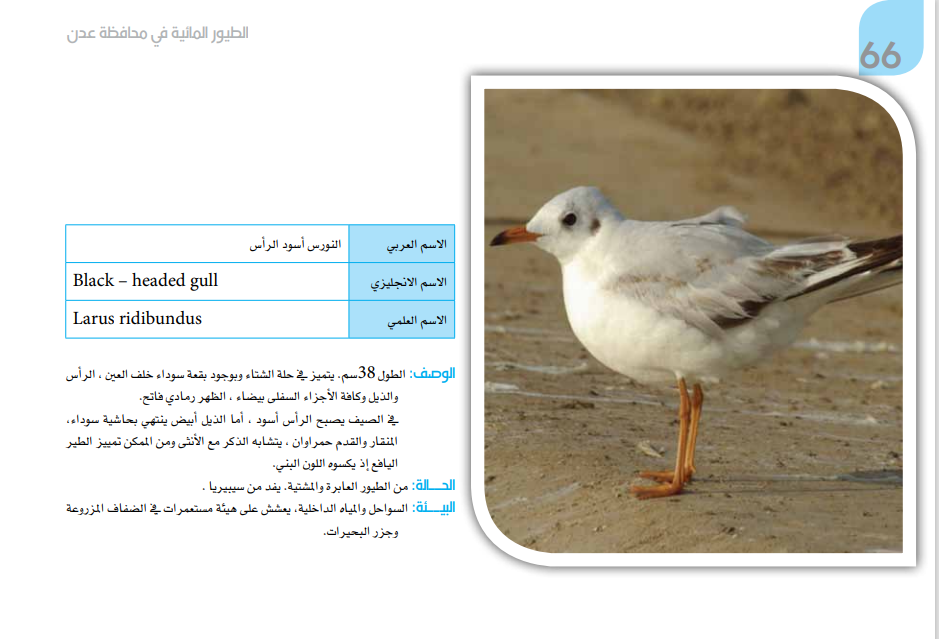
Part of waterfowl in Aden (Waterfowl in Aden: Instruction Manual-Yemeni Ministry of Water and Environment-The United Nations Development Programme (UNDP).
English name: Black-headed gull.
Scientific name: Larus ridibundus.
Description: It is a 38 cm long winter bird. It has a black mark behind its eye. Its head, tail and all lower parts are white while its back is a light gray.
In the summer, the head turns into black. Its tail is white and ends with a black edge. The beak and legs are red. Males are similar to females. The adult can be distinguished by the dominant brown color.
The status: It is a winter transcontinental bird that migrates from Siberia.
Environment: Coasts and inner water. Its nests are in the form of colonies in the agricultural banks and lake’s isles.
He warned of the danger posed by the pollutants in the PLR, especially the plastic materials which can be life-threatening for hungry birds and other marine organisms such as sea turtles.
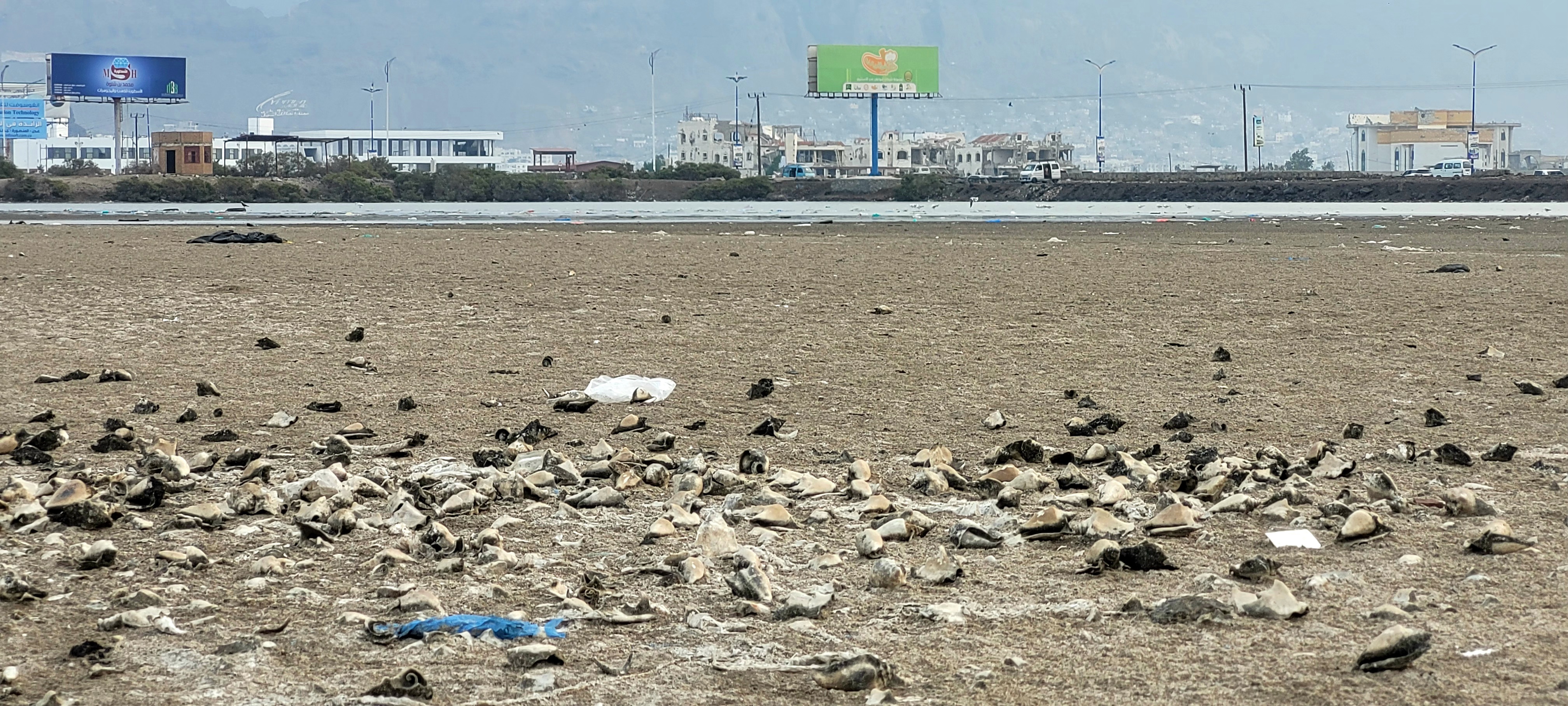
Environmental pollution in PLR in Aden, October 27, 2023 (South24 Center).
Necessary steps
The Yemeni law provides a big space for the executive authorities on the ground to take several steps to protect the environment and the natural reserves. Law No (26) in 1995 stipulates on “banning and combating the activities that lead to devastation of the natural environment, harm the wild and marine life and reduce their beauty”.
Moreover, in 2006, Yemen signed the 1971 ’Ramsar Convention‘ on ‘Wetlands of International Importance especially as Waterfowl Habitat’. Despite these national and international legislations, there has not been much work done on the ground to conserve these reserves.
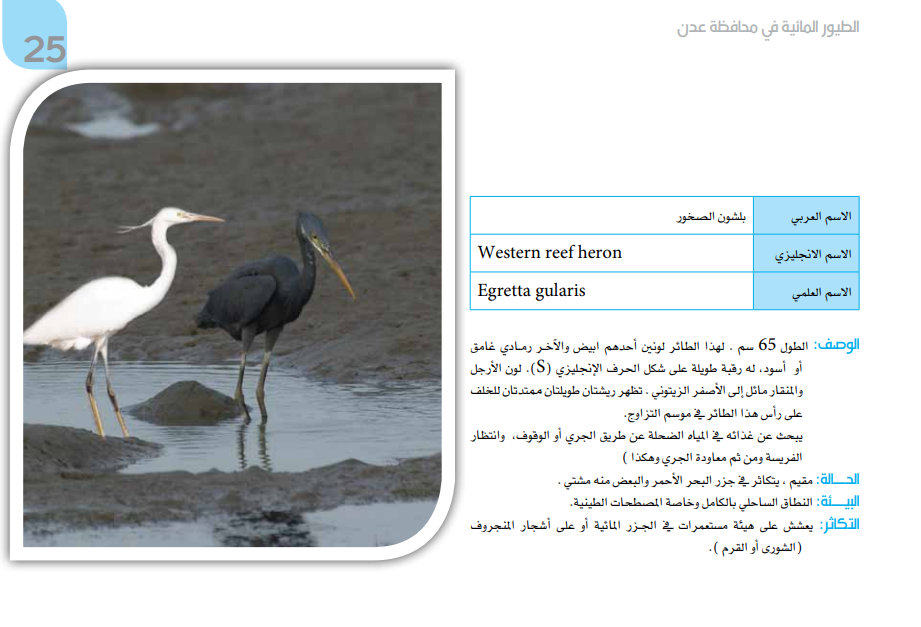
Part of waterfowl in Aden (Waterfowl in Aden: Instruction Manual-Yemeni Ministry of Water and Environment-The United Nations Development Programme (UNDP).
English name: Western reef heron.
Scientific name: Egretta gularis.
Description: It is 65 cm long. The bird has two colors, the white and the dark grey or the black. It has a long neck which takes the shape of the English letter “S''. The legs and the bleak are olive yellow. There are two long extended feathers on the head of this bird during the mating season. It searches for food in shallow water through running, standing, and waiting for the prey.
The status: A resident bird which produces offspring in the Red Sea’s isles. Some of western reef heron are winter birds.
The environment: The whole coastal areas, especially the muddy bodies.
Producing offspring: It makes nests in the form of colonies in the isles or on the mangrove trees (Avicennia).
Dr. Jamal Bawazir stressed that maintaining PLR and the other reserves in Aden is especially important. He called for turning the reserve into a natural park based on environmental conditions. According to him, awareness needs to be raised about the environmental importance of the wetland’s reserves in addition to developing the mechanisms to protect and improve the reserves for environmental tourism in the city. He recommended that schools and environmental clubs should be encouraged to develop the hobby of monitoring the bird population in the reserves.
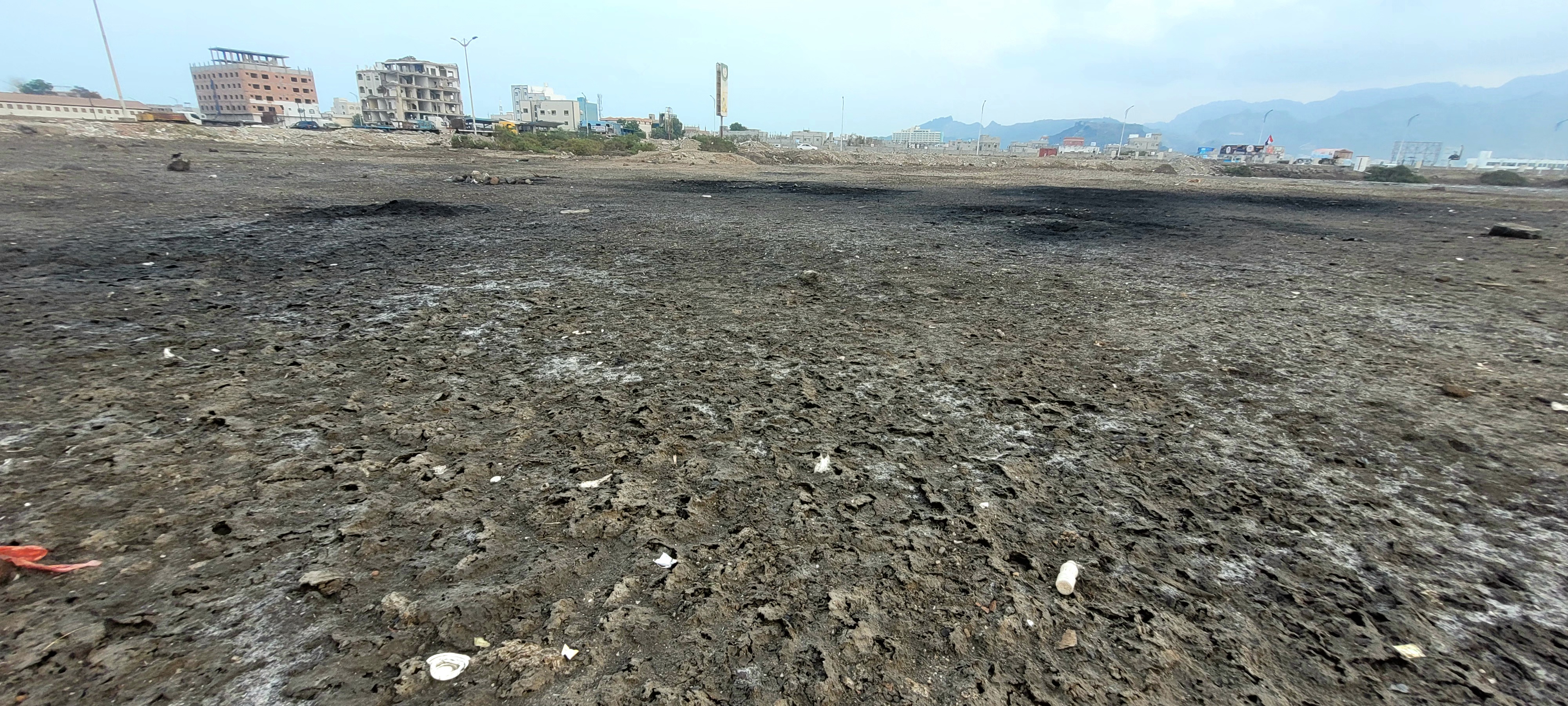
An eyesore: Environmental pollution in PLR in Aden, October 27, 2023 (South24 Center).
On October 14, the World Migratory Bird Day was celebrated to raise awareness about the importance of conservation of migratory birds and protection of their habitats. The report ’State of the World’s Birds 2022‘, issued by ‘BirdLife International’, indicates that nearly half of all bird species are in decline, with more than one in eight at risk of extinction. It said: “The pressures causing these declines are well understood, and the vast majority are driven by human actions… The challenges to conservation are escalating, and time is running out.”